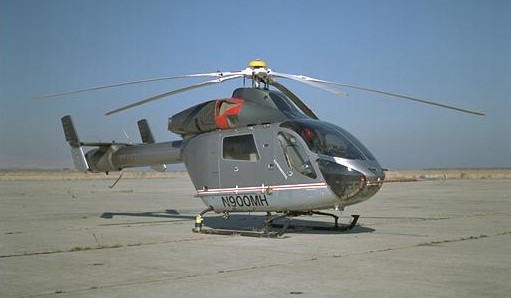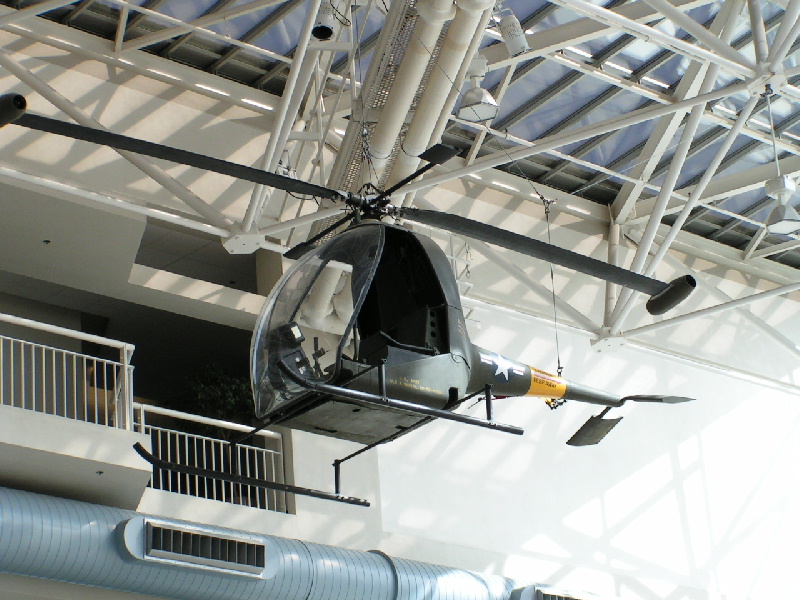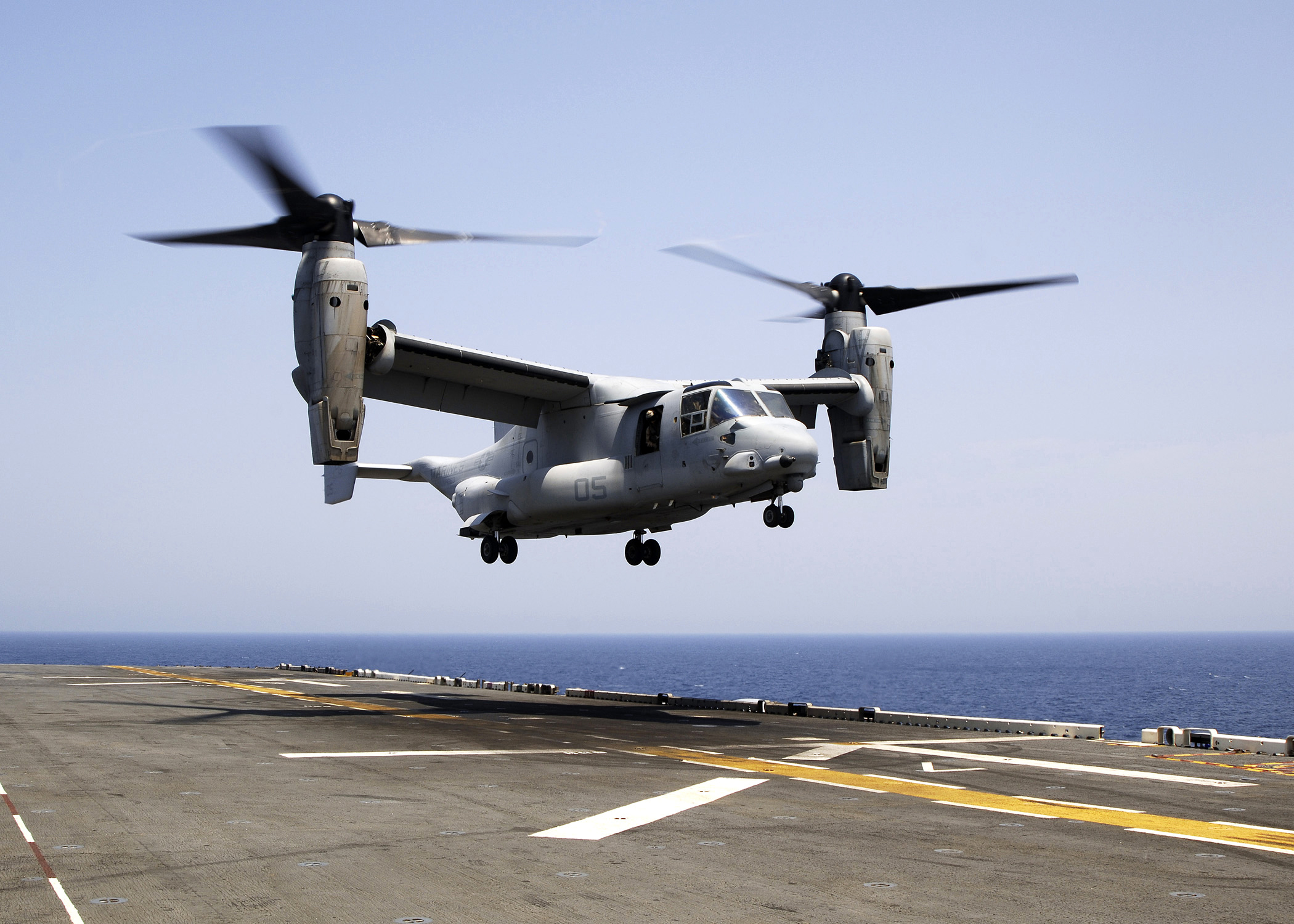|
NOTAR Helicopters
NOTAR ("no tail rotor") is a helicopter system which avoids the use of a tail rotor. It was developed by MD Helicopters, McDonnell Douglas Helicopter Systems (through their acquisition of Hughes Helicopters). The system uses a fan inside the tail boom to build a high volume of low-pressure air, which exits through two slots and creates a boundary layer flow of air along the tailboom utilizing the Coandă effect. The boundary layer changes the direction of airflow around the tailboom, creating thrust opposite the motion imparted to the fuselage by the torque effect of the main rotor. Directional yaw control is gained through a vented, rotating drum at the end of the tailboom, called the direct jet thruster. Advocates of NOTAR assert that the system offers quieter and safer operation than a traditional tail rotor. Development The use of directed air to provide anti-torque control had been tested as early as 1945 in the British Cierva W.9. During 1957, a Spanish prototype designed ... [...More Info...] [...Related Items...] OR: [Wikipedia] [Google] [Baidu] |
MD Helicopters MD Explorer
The MD Helicopters MD Explorer is a light twin-engined utility helicopter designed and initially produced by the American rotorcraft specialist McDonnell Douglas Helicopter Systems. On 18 December 1992, the maiden flight was conducted, initial certification for the type followed roughly two years later. The initial model, the MD 900, was joined by an improved successor, the MD 902, during the late 1990s. The Explorer is currently produced by MD Helicopters. The helicopter is noted for having no tail rotor, using the NOTAR technology instead, giving its tail a unique appearance and quieter sound profile than a more traditional tail rotor. Development In January 1989, McDonnell Douglas Helicopters officially announced the launch of the Explorer, which it initially referred to as the ''MDX''. Amongst other things, the Explorer was the first McDonnell Douglas helicopter to incorporate the NOTAR system from its initial design.Frawley 2003, p. 156. McDonnell Douglas partnered with de ... [...More Info...] [...Related Items...] OR: [Wikipedia] [Google] [Baidu] |
Youngcopter Neo
The Youngcopter Neo () is a German NOTAR helicopter that was designed by Björn Jung and is under development by his company, Youngcopter of Mainz. It was first publicly introduced at the ILA Berlin Air Show in 2008. The aircraft is intended to be supplied as a kit for amateur construction.Tacke, Willi; Marino Boric; et al: ''World Directory of Light Aviation 2015-16'', page 212. Flying Pages Europe SARL, 2015. No projected date has been announced for kit deliveries and no pricing has been set as of January 2018. Design and development The Neo was designed to comply with the amateur-built aircraft construction rules. The first prototype A prototype is an early sample, model, or release of a product built to test a concept or process. It is a term used in a variety of contexts, including semantics, design, electronics, and Software prototyping, software programming. A prototype ... was completed in 2008 and ground run. By 2010 ground testing had been completed, includi ... [...More Info...] [...Related Items...] OR: [Wikipedia] [Google] [Baidu] |
Tip Jet
A tip jet is a jet nozzle at the tip of some helicopter rotor blades, used to spin the rotor, much like a Catherine wheel firework. Tip jets replace the normal shaft drive and have the advantage of placing no torque on the airframe, thus not requiring the presence of a tail rotor. Some simple monocopters are composed of nothing but a single blade with a tip rocket. Tip jets can use compressed air, provided by a separate engine, to create jet thrust. Other types use a system that functions similarly to the afterburner (reheat) on a conventional jet engine, except that instead of reheating a gas jet, they serve as the primary heater, creating greater thrust than the flow of pre-compressed air alone; the best description of this is ''thrust augmentation''. Other designs includes ramjets or even a complete turbojet engine. Some, known as ''rocket-on-rotor'' systems, involve placing rockets on the tips of the rotor blades that are fueled from a tank. If the helicopter's engine fail ... [...More Info...] [...Related Items...] OR: [Wikipedia] [Google] [Baidu] |
Tiltrotors
A tiltrotor is an aircraft that generates lift and propulsion by way of one or more powered rotors (sometimes called ''proprotors'') mounted on rotating shafts or nacelles usually at the ends of a fixed wing. Almost all tiltrotors use a transverse rotor design, with a few exceptions that use other multirotor layouts. Tiltrotor design combines the VTOL capability of a helicopter with the speed and range of a conventional fixed-wing aircraft. For vertical flight, the rotors are angled so the plane of rotation is horizontal, generating lift the way a normal helicopter rotor does. As the aircraft gains speed, the rotors are progressively tilted forward, with the plane of rotation eventually becoming vertical. In this mode the rotors provide thrust as a propeller, and the airfoil of the fixed wings takes over providing the lift via the forward motion of the entire aircraft. Since the rotors can be configured to be more efficient for propulsion (e.g. with root-tip twist) and it ... [...More Info...] [...Related Items...] OR: [Wikipedia] [Google] [Baidu] |
Quadrotor
A quadcopter, also called quadrocopter, or quadrotor is a type of helicopter or multicopter that has four rotors. Although quadrotor helicopters and convertiplanes have long been flown experimentally, the configuration remained a curiosity until the arrival of the modern unmanned aerial vehicle or drone. The small size and low inertia of drones allows use of a particularly simple flight control system, which has greatly increased the practicality of the small quadrotor in this application. Design principles Each rotor produces both lift and torque about its center of rotation, as well as drag opposite to the vehicle's direction of flight. Quadcopters generally have two rotors spinning clockwise (CW) and two counterclockwise (CCW). Flight control is provided by independent variation of the speed and hence lift and torque of each rotor. Pitch and roll are controlled by varying the net centre of thrust, with yaw controlled by varying the net torque. Unlike conventional helic ... [...More Info...] [...Related Items...] OR: [Wikipedia] [Google] [Baidu] |
Multirotor
A multirotor or multicopter is a rotorcraft with more than two lift-generating rotors. An advantage of multirotor aircraft is the simpler rotor mechanics required for flight control. Unlike single- and double-rotor helicopters which use complex variable pitch rotors whose pitch varies as the blade rotates for flight stability and control, multirotors often use fixed- pitch blades; control of vehicle motion is achieved by varying the relative speed of each rotor to change the thrust and torque produced by each. Due to their ease of both construction and control, multirotor aircraft are frequently used in radio control aircraft and unmanned aerial vehicle (UAV) (drone) projects in which the names tricopter, quadcopter, hexacopter and octocopter are frequently used to refer to 3-, 4-, 6- and 8-rotor rotorcraft, respectively. There is also the X8 (also called ''octo-quad'') configuration that is similar to the quadracopter design, except that it has eight rotors; the lower of wh ... [...More Info...] [...Related Items...] OR: [Wikipedia] [Google] [Baidu] |
Transverse Rotors
A transverse-rotor aircraft is an aircraft with two large Horizontal plane, horizontal helicopter rotor, rotor assemblies mounted side by side. Single-rotor helicopters (unicopters) need an additional tail rotor or NOTAR, tail exhaust to neutralize the reaction (physics), reactional angular momentum produced by the main rotor. Transverse rotor helicopters, however, use counter-rotating rotors, with each cancelling out the other's torque. Counter-rotating rotor blades also won't collide with and destroy each other if they flex into the other rotor's pathway. In addition, transverse rotor configuration has the advantage of higher payload with shorter airfoil, blades, since there are two sets working to provide lift (force), lift. Also, all of the power from the engines can be used for lift, whereas a single-rotor helicopter must divert part of its engine power to generate tail thrust. Transverse rotor design with rotatable nacelles are known as tiltrotors while designs where ... [...More Info...] [...Related Items...] OR: [Wikipedia] [Google] [Baidu] |
Tandem Rotors
A tandem-rotor aircraft is an aircraft with two large helicopter rotor assemblies mounted one in front of the other in the horizontal plane. This configuration is mainly used for large cargo helicopters. Such aircraft are often informally referred to as "Chinooks," after the CH-47 Chinook, one of the first widely adopted heavy-lift helicopters with a tandem-rotor configuration. Design Single-rotor helicopters need a mechanism to neutralize the yawing movement produced by the single large rotor. This is commonly accomplished by a tail rotor, coaxial rotors, and the NOTAR systems. Tandem-rotor helicopters, however, use counter-rotating rotors, with each cancelling out the other's torque. Therefore, all of the power from the engines can be used for lift, whereas a single-rotor helicopter uses some of the engine power to counter the torque. An alternative is to mount two rotors in a coaxial configuration. The first successful tandem-rotor helicopter was built by Nicolas Flo ... [...More Info...] [...Related Items...] OR: [Wikipedia] [Google] [Baidu] |
Intermeshing Rotors
An intermeshing-rotor helicopter (or synchropter) is a helicopter with a set of two main rotors turning in opposite directions, with each rotor mast mounted with a slight angle to the other, in a transversely symmetrical manner, so that the blades intermesh without colliding. The arrangement allows the helicopter to function without a tail rotor, which saves power. However, neither rotor lifts directly vertically, which reduces efficiency per each rotor. Yaw is accomplished through varying torque, which is done by increasing collective pitch on one of the blade sets. Most intermeshing designs have two blades per mast, although exceptions such as the Kellett XR-10 with three blades per mast do exist. The arrangement was developed in Germany by Anton Flettner for a small anti-submarine warfare helicopter, the Flettner Fl 265 as the pioneering example, and later the Flettner Fl 282 Kolibri. During the Cold War the American Kaman Aircraft company produced the HH-43 Huskie ... [...More Info...] [...Related Items...] OR: [Wikipedia] [Google] [Baidu] |
Fenestron
A Fenestron (sometimes alternatively referred to as a fantail or a "fan-in-fin" arrangementLeishman 2006, p. 321.) is an enclosed helicopter tail rotor that operates like a ducted fan. The term ''Fenestron'' is a trademark of multinational helicopter manufacturing consortium Airbus Helicopters (formerly known as Eurocopter). The word itself comes from the Occitan term for a ''small window'', and is ultimately derived from the Latin word ''fenestra'' for ''window''.Prouty, Ray. ''Helicopter Aerodynamics'', Helobooks, 1985, 2004. p. 266. Like the conventional tail rotor it replaces, a Fenestron counteracts the torque generated by the main rotor. However, it differs from a conventional open tail rotor by being integrally housed within the tail boom. While conventional tail rotors typically have between two and six blades, Fenestrons have between seven and eighteen blades; these may have variable angular spacing so that the noise is distributed over different frequencies. By placing ... [...More Info...] [...Related Items...] OR: [Wikipedia] [Google] [Baidu] |
Coaxial Rotors
A coaxial-rotor aircraft is an aircraft whose helicopter rotor, rotors are mounted one above the other on Concentric objects, concentric shafts, with the same axis of rotation, but turning in opposite directions (contra-rotating). This rotor configuration is a feature of helicopters produced by the Russian Kamov helicopter design bureau. History The idea of coaxial rotors originates with Mikhail Lomonosov. He had developed a small helicopter model with coaxial rotors in July 1754 and demonstrated it to the Russian Academy of Sciences. In 1859, the British Patent Office awarded the first helicopter patent to Henry Bright for his coaxial design. From this point, coaxial helicopters developed into fully operational machines as we know them today. Two pioneering helicopters, the Corradino D'Ascanio#Between the wars, Corradino D'Ascanio-built "D'AT3" of 1930, and the generally more successful French mid-1930s ''Gyroplane Laboratoire'', both used coaxial rotor systems for flight. ... [...More Info...] [...Related Items...] OR: [Wikipedia] [Google] [Baidu] |










